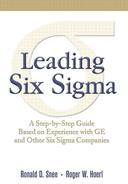Developing the Project Charter
The project charter has a critical impact on project success. This one-page document summarizes the key aspects of the project, in effect, defines what management wants done and what the Black Belt and Champion have agreed to accomplish. It forms a contract between all parties involved in the project.
Experience has shown that many continuous improvement projects fail because of misunderstandings among the team, the project leader, the customer, or management. For example, a team may proudly present a completed project that developed a web-based system for underwriting U.S. commercial credit lines for a leasing company. Management may have expected an internationalized version, however, and view the project as inadequate because it cannot be used in either Europe or Asia. A clear, concise, project charter avoids such misunderstandings and helps protect the project team from being second-guessed.
The charter is drafted by the Project Champion, refined by the Project Champion and Black Belt, and approved by the leadership team. It is not unusual for the charter to be revised a few times as the problem is better understood and data become available. Somewhere near the end of the measure phase the charter should define the scope of work that the project will accomplish. If such commitment is not made it will be hard for the project to satisfy expectations. It will be like trying to hit a moving target if the expectations, as defined by the charter, are constantly changing.
Figure 4-1 shows a template we have used for project charters that is similar to the template of Harry and Schroeder (2000). It is important that all the information required by the project charter be reported in the template. Blank entries are not acceptable. There are some potential problems for which you should be on the lookout.
Figure 4-1. Six Sigma Project Charter Template

It should be clear what process you are trying to improve (Charter Element 1). The process provides the focus and context for the work. A clear process definition helps the Black Belt see where the work will focus and what needs to be accomplished. Identifying the process is often difficult for those persons and organizations that are not skilled in thinking about their work as a series of interconnected processes.
The scope should be clear and attainable in less than a four to six month period (Charter Elements 2 and 6). Many projects fail because the scope is too big for the allotted time. Answering the question “Can we get this work done in less than four to six months (or whatever the required time frame)?” is a very effective way to test whether the project is properly scoped.
Keen attention should be paid to the process metrics (Charter Element 3). These measurements focus the Black Belt on the aspects of process performance that need to be improved, and the quantitative goals for the project. They are also used to calculate the financial impact of the project.
Leaving this section of the charter blank is not acceptable because the project will not be successful without the metrics, and should not proceed until data are available to properly define the project and allow you to calculate business impact.
The baseline, goal, and entitlement values for each of the key process metrics should be entered in the charter. You should include the metrics you want to improve as well as the metrics you don't want to negatively influence. For example, if the project is a capacity improvement project, and it is particularly important that product quality doesn't deteriorate, then both capacity and quality metrics should be addressed in the charter.
It is important that the business impact of the project is determined (Charter Element 4). This should identify both hard dollars (cost savings and profits from increased sales) that flow to the bottom line, as well as any soft dollar benefits such as cost avoidance. Many organizations deploying Six Sigma, including GE, only consider the hard benefits when publishing savings from the effort. Even when only hard benefits are reported, you should also document planned soft benefits in the charter. Leaving this section blank is unacceptable because without quantitative knowledge there will be no way of knowing what the project is worth and whether it is the right project on which to be working.
The project team should be small and not have more than four to six members (Charter Element 5). It is important that the team members be identified by name in the charter to ensure that each is available to work on the project. The team can include specialists and technical experts as needed. All core team members should be available for at least 25% of their time. A common pitfall is having team members that are overloaded and not available to work on the project.
Another key item is the project schedule (Charter Element 8). As noted earlier the project should be scheduled for completion in less than 4-6 months. Some will try to resist such an aggressive schedule. Projects scheduled for competition in more than six months is another way a project can fail. The scope of projects taking longer than six months should be reduced, or serious consideration should be given to dividing the work into more than one project.
Once the project charter has been developed you are in a position to select the Black Belt and Champion who will be responsible for doing the project. The critical step of selecting the right people for your Six Sigma initiative is addressed in the next section.
